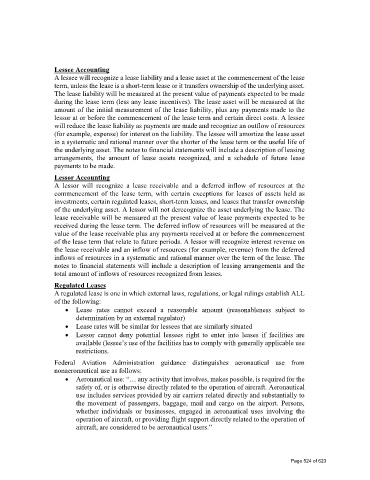Page 524 - FortWorthFY23AdoptedBudget
P. 524
Lessee Accounting
A lessee will recognize a lease liability and a lease asset at the commencement of the lease
term, unless the lease is a short-term lease or it transfers ownership of the underlying asset.
The lease liability will be measured at the present value of payments expected to be made
during the lease term (less any lease incentives). The lease asset will be measured at the
amount of the initial measurement of the lease liability, plus any payments made to the
lessor at or before the commencement of the lease term and certain direct costs. A lessee
will reduce the lease liability as payments are made and recognize an outflow of resources
(for example, expense) for interest on the liability. The lessee will amortize the lease asset
in a systematic and rational manner over the shorter of the lease term or the useful life of
the underlying asset. The notes to financial statements will include a description of leasing
arrangements, the amount of lease assets recognized, and a schedule of future lease
payments to be made.
Lessor Accounting
A lessor will recognize a lease receivable and a deferred inflow of resources at the
commencement of the lease term, with certain exceptions for leases of assets held as
investments, certain regulated leases, short-term leases, and leases that transfer ownership
of the underlying asset. A lessor will not derecognize the asset underlying the lease. The
lease receivable will be measured at the present value of lease payments expected to be
received during the lease term. The deferred inflow of resources will be measured at the
value of the lease receivable plus any payments received at or before the commencement
of the lease term that relate to future periods. A lessor will recognize interest revenue on
the lease receivable and an inflow of resources (for example, revenue) from the deferred
inflows of resources in a systematic and rational manner over the term of the lease. The
notes to financial statements will include a description of leasing arrangements and the
total amount of inflows of resources recognized from leases.
Regulated Leases
A regulated lease is one in which external laws, regulations, or legal rulings establish ALL
of the following:
• Lease rates cannot exceed a reasonable amount (reasonableness subject to
determination by an external regulator)
• Lease rates will be similar for lessees that are similarly situated
• Lessor cannot deny potential lessees right to enter into leases if facilities are
available (lessee’s use of the facilities has to comply with generally applicable use
restrictions.
Federal Aviation Administration guidance distinguishes aeronautical use from
nonaeronautical use as follows:
• Aeronautical use: “… any activity that involves, makes possible, is required for the
safety of, or is otherwise directly related to the operation of aircraft. Aeronautical
use includes services provided by air carriers related directly and substantially to
the movement of passengers, baggage, mail and cargo on the airport. Persons,
whether individuals or businesses, engaged in aeronautical uses involving the
operation of aircraft, or providing flight support directly related to the operation of
aircraft, are considered to be aeronautical users.”
Page 524 of 623

